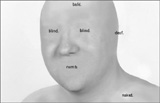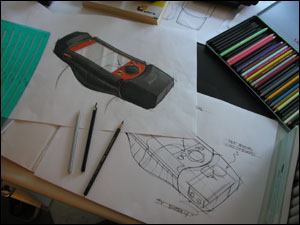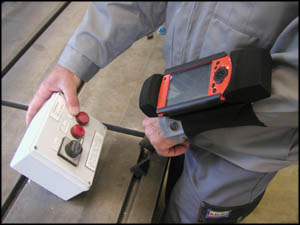
the abb mobile service technician
This project has developed a functional prototype of an arm-worn, wearable mobile computing
system, designed to allow service technicians access to particular information and services
in order to respond to breakdowns and sudden stops that occur in the production line.
In order to understand the user group's work practice, i.e. how people actually go about
with their everyday work, solve problems, and keep the organization operative, we conducted
an exploratory ethnographic study at two industrial manufacturing sites during 2001;
Volvo Trucks in Umea and Volvo Cars in Gothenburg, both of which are large Swedish vehicle
manufacturing companies.
Based in the empirical findings, a highly multidisciplinary design
team has planned, designed, and implemented an arm-worn wearable computer prototype system.
Design incentives have also come from theory, mainly in terms of the concept of embodiment
as introduced within the phenomenological discourse.
This project may as such be seen as an effort of bringing the ideas of embodiment to play
in the context of mobile computing and specifically in mobile human.computer interaction, where
the prototype shows three styles of interaction not generally found in mobile interaction:
first, the system itself is embodied in a literal sense on the user, as it is arm worn as
opposed to handheld; second, it allows the user to interact with the physical environment by
pointing; and third, it allows by tilting the device itself one-hand navigation of a graphical
user interface that is substantially larger than the screen.


Project Title:
The ABB Mobile Service Technician
Project Leader:
Other People:
Niklas Andersson, Interaction Design Lab
Anders Hasselqvist, Thomas Lundqvist, and Bjorn Yttergren, Department of Applied Physics and Electronics, Umea University
Anders Hasselqvist, Thomas Lundqvist, and Bjorn Yttergren, Department of Applied Physics and Electronics, Umea University
Funding:
Executive Summary:
Based on the findings of an ethnographic study at two vehicle manufacturing companies, we have designed and implemented computer support system for service technicians. The system is arm-worn as opposed to traditionally handheld. It allows the user to interact with the physical environment by pointing as well as it lets the user one-hand navigation of the graphical user interface by tilt.
Aims and Goals:
The research goals of this project are to explore novel interaction styles, pointing and tilting, for mobile human-computer interaction applied in a specific work environment.
additional material
|
|
Click here
to download a poster on ABB Mobile Service Technician project
(Poster is in .pdf format, 1 mb) |